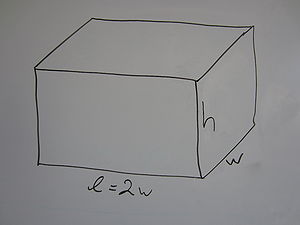Science:Math Exam Resources/Courses/MATH104/December 2013/Question 04/Solution 1
We wish to minimize the cost, C, subject to the constraint that the length of the base is twice it's width and that the volume of the container must be .
The cost C can be expressed as the sum of the costs for all the sides. Recall that this is an open-top box (i.e., no top). If we let l, w, and h denote the length, width, and height of the box in metres, respectively, then:
since material for the base costs $4.50 per square metre, and material for the sides costs $6 per square metre.
We are also given the constraint
Using the fact that the length is twice the width (i.e., l = 2w), the cost function and volume constraint are expressed as
To reduce this into a single variable problem, we use the constraint to express the height of the box in terms of the width:
and substitute this into the cost function C, making it a function of w only:
To optimize C, we determine first determine its critical points by differentiating with respect to w and setting the derivative equal to zero:
Therefore w = 2 is a critical point. To determine whether or not it is the point that minimizes C, we use the second derivative test. The second derivative of C with respect to w is
which is clearly greater than zero when w = 2. Thus, by the second derivative test, C has a local minimum at w = 2 (Moreover, it is the global minimum since there are no other critical points.) Substituting w = 2 into the cost function, we determine that the minimum cost is









